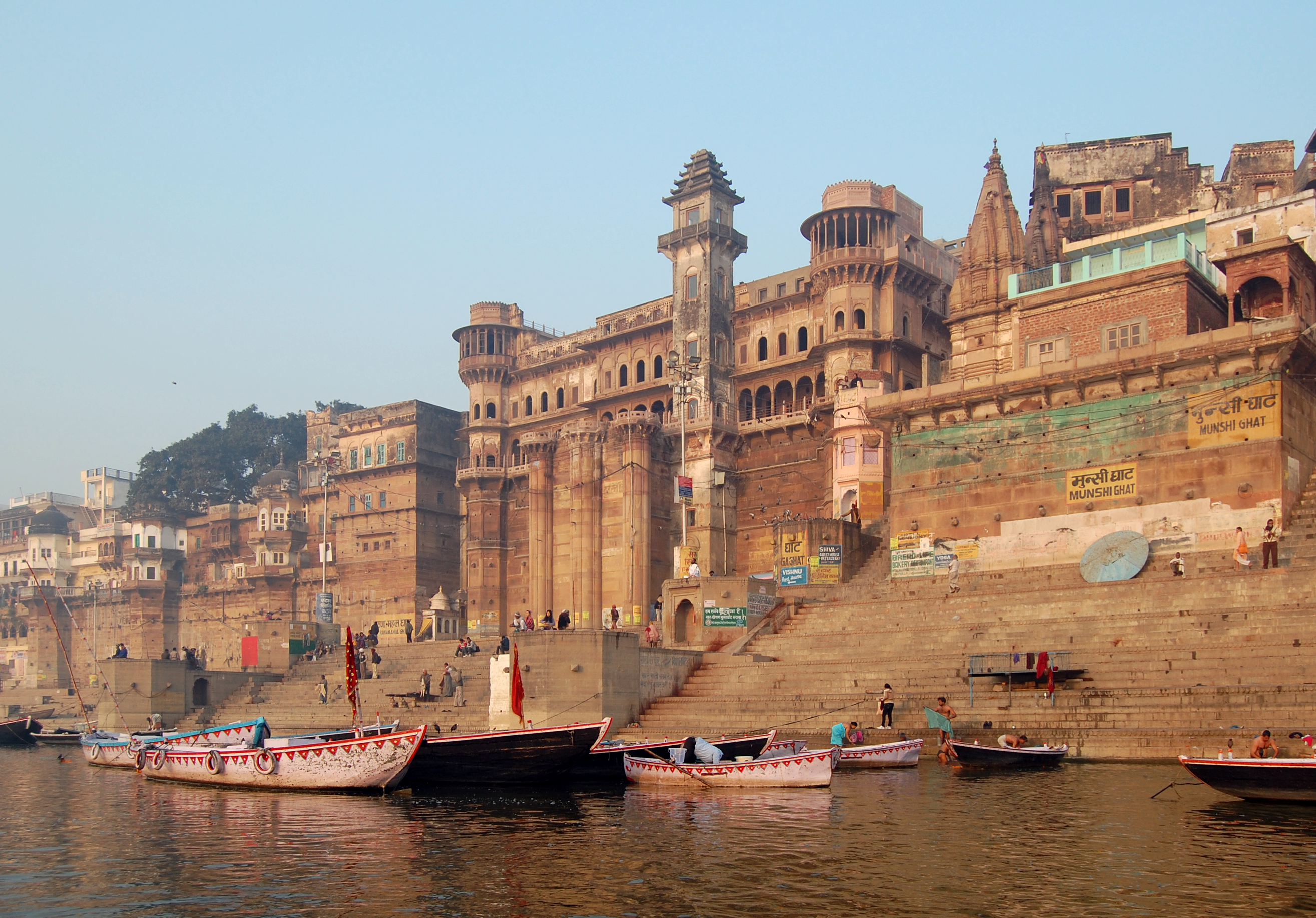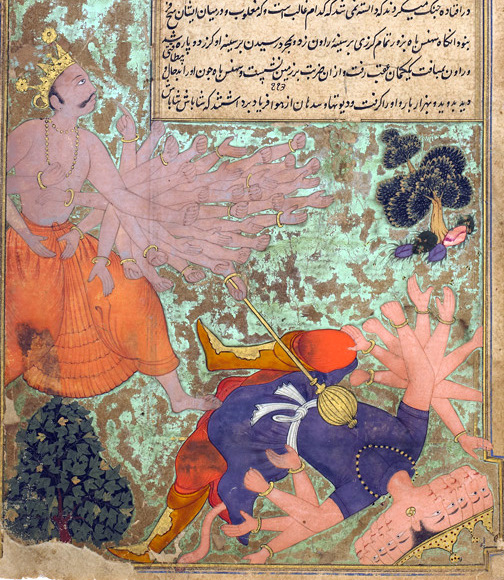|
Traikutaka Dynasty
The Traikutakas were a dynasty of Indian kings who ruled between 388 and 456. The name "Traikutakas" seems to be derived from the words for a three-peaked mountain ("Tri-kuta"). The Traikutakas are mentioned in Kalidasa's Raghuvamsa, in which they are located in the area of northern Konkan. The dominions of the Traikutakas further included Aparanta and northern Maharashtra. The coins of the Traikutaras are found extensively in southern Gujarat, and southern Maharashtra beyond the Ghats. Their design is very close to that of the Western Satraps, from which they probably inherited some territories, and traces of the obverse legend with Greek letters can still be seen. Traikuta rule of Aparanta or Konkan begins in A.D. 248 (Traikuta era) exactly the time of Abhira Ishwarsena rule, hence Traikutas are identified with the dynasty of Abhiras. The Traikutakas reckoned in a specific era, known as the Traikutaka era, or usually the Kalachuri or Chedi era, starting in 249. History It ... [...More Info...] [...Related Items...] OR: [Wikipedia] [Google] [Baidu] |
Dharasena (ruler)
Dharasena was a Traikutaka ruler of the Konkan coast. He was the son of the Traikutaka ruler Indradatta and succeeded him as king. He is known to have performed an ''ashwamedha'' horse sacrifice and was succeeded by his son Vyaghrasena. Reign King Dahrasena expanded his realm, which soon bordered the Vakataka realm. This led to conflict and the Vakataka king Narendrasena, who with the help of his son & crown prince Prithivishena, probably defeated the Traikutikas, as later king Prithivishena's inscriptions refer to him twice rescuing the "sunken fortunes of his family". See also *Abhira dynasty *Konkan *Kumaragupta I Kumaragupta I (Gupta script: ''Ku-ma-ra-gu-pta'', r. c. 415–455 CE) was an emperor of the Gupta Empire of Ancient India. A son of the Gupta emperor Chandragupta II and queen Dhruvadevi, he seems to have maintained control of his inherited te ... References {{DEFAULTSORT:Dharasena 5th-century Indian monarchs ... [...More Info...] [...Related Items...] OR: [Wikipedia] [Google] [Baidu] |
Ghats
Ghat, a term used in the Indian subcontinent, depending on the context could refer either to a range of stepped hills with valleys (ghati in Hindi), such as the Eastern Ghats and Western Ghats; or the series of steps leading down to a body of water or wharf, such as a bathing or cremation place along the banks of a river or pond, the Ghats in Varanasi, Dhobi Ghat or the Aapravasi Ghat.Sunithi L. Narayan, Revathy Nagaswami, 1992Discover sublime India: handbook for tourists Page 5.Ghat definition Cambridge dictionary. Roads passing through ghats are called . Etymology The origin of the English 'ghat' is sa, घट्ट , ' and is normally translated as ghaṭ, quay, landing or ...[...More Info...] [...Related Items...] OR: [Wikipedia] [Google] [Baidu] |
Heheya Kingdom
The Heheya Kingdom (also known as Haihaya, Haiheya, Heiheya _sa.html" ;"title="nowiki/> sa">हैहय was a kingdom ruled by the Yadava people, who claimed to be descended from Yadu, a legendary king of Chandravamsha lineage. One of the most well known Haihaya rulers was Kartavirya Arjuna. It is believed that the Kingdom was involved with a number of conflicts with neighboring kingdoms, and it is believed that it was ultimately defeated by the Bhargava leader Parashurama. The capital of the Heheya Kingdom was Mahishmati, located on the banks of the Narmada River in present-day Madhya Pradesh. Haihaya clans The Haihayas were an ancient confederacy of five ''gana''s (clans), who claimed their common ancestry from Yadu. According to the ''Harivamsha Purana'' (34.1898), Haihaya was the great-grandson of Yadu and grandson of Sahasrajit.Pargiter, F.E. (1972) 922 ''Ancient Indian Historical Tradition'', Delhi: Motilal Banarsidass, p.87. In the ''Vishnu Purana'' (IV.11), al ... [...More Info...] [...Related Items...] OR: [Wikipedia] [Google] [Baidu] |
Yadav Caste
Yadav refers to a grouping of traditionally non-elite, Quote: "The Yadavs were traditionally a low-to-middle-ranking cluster of pastoral-peasant castes that have become a significant political force in Uttar Pradesh (and other northern states like Bihar) in the last thirty years." peasant- pastoral communities or castes in India that since the 19th and 20th centuries Quote: "In a not dissimilar way the various cow-keeping castes of northern India were combining in 1931 to use the common term of Yadava for their various castes, Ahir, Goala, Gopa, etc., and to claim a Rajput origin of extremely doubtful authenticity." have claimed descent from the mythological king Yadu as a part of a movement of social and political resurgence. Quote: "The movement, which had a wide interregional spread, attempted to submerge regional names such as Goala, Ahir, Ahar, Gopa, etc., in favour of the generic term Yadava (Rao 1979). Hence a number of pastoralist castes were subsumed under Yadava, in ... [...More Info...] [...Related Items...] OR: [Wikipedia] [Google] [Baidu] |
Vaishnav
Vaishnavism ( sa, वैष्णवसम्प्रदायः, Vaiṣṇavasampradāyaḥ) is one of the major Hindu denominations along with Shaivism, Shaktism, and Smartism. It is also called Vishnuism since it considers Vishnu as the sole Para Brahman, supreme being leading all other Hindu deities, i.e. ''Mahavishnu''. Its followers are called Vaishnavites or ''Vaishnava''s (), and it includes sub-sects like Krishnaism and Ramaism, which consider Krishna and Rama as the supreme beings respectively. According to a 2010 estimate by Johnson and Grim, Vaishnavism is the largest Hindu sect, constituting about 641 million or 67.6% of Hindus. The ancient emergence of Vaishnavism is unclear, and broadly hypothesized as a History of Hinduism, fusion of various regional non-Vedic religions with Vishnu. A merger of several popular non-Vedic theistic traditions, particularly the Bhagavata cults of Vāsudeva, Vāsudeva-krishna and ''Gopala-Krishna, Gopala-Krishna'', and Narayana, ... [...More Info...] [...Related Items...] OR: [Wikipedia] [Google] [Baidu] |
Prithivishena II
Prithivishena II (IAST: ''Pṛthivīṣeṇa''; ) was a ruler of the Nandivardhana-Pravarapura branch of the Vakataka dynasty. He succeeded his father Narendrasena as Maharaja. Prithivishena II is the last known king of the main Vakataka line, which is no longer attested after his reign. Early life Prithivishena was born to Narendrasena and his wife Ajjhitabhattarika, a princess of Kuntala. He was probably born while his father was still a Crown Prince during the reign of Pravarasena II, Prithivishena's grandfather. A.S. Altekar suggests that when Prithivishena was a youth of about 20 years, he aided his father in repulsing the Nalas of the Bastar region who had invaded the Vakataka kingdom. Reign Prithivishena's inscriptions refer to him twice rescuing the "sunken fortunes of his family". It is unclear what these two instances were. Altekar suggests that the first instance was the aforementioned repulsion of the Nalas during the reign of Prithivishena's father, and the secon ... [...More Info...] [...Related Items...] OR: [Wikipedia] [Google] [Baidu] |
Narendrasena
Narendrasena () was a ruler of the Nandivardhana-Pravarapura branch of the Vakataka dynasty. He succeeded his father Pravarasena II as Maharaja. Early life Narendrasena was possibly born to Ajnakabhattarika, who may have been the chief queen of Pravarasena II and is mentioned as the mother of "Narindaraja" (possibly referring to Narendrasena) in a charter from Pravarasena's 16th regnal year. Sometime during his father's reign, Narendrasena was married to a princess named Ajjhitabhattarika who was described as the daughter of the "king of Kuntala". It is not known for certain who this "king of Kuntala" was, but he is often identified with the Kadamba king Kakusthavarman who is known to have married his daughters into several prominent royal families. Reign The death of Pravarasena II may have been followed by a succession struggle, from which Narendrasena emerged victorious. The Vakataka records state that Narendrasena had to "regain the fortunes of his family" after sufferi ... [...More Info...] [...Related Items...] OR: [Wikipedia] [Google] [Baidu] |
Vakataka Dynasty
The Vakataka dynasty () was an ancient Indian dynasty that originated from the Deccan in the mid-3rd century CE. Their state is believed to have extended from the southern edges of Malwa and Gujarat in the north to the Tungabhadra River in the south as well as from the Arabian Sea in the west to the edges of Chhattisgarh in the east. They were the most important successors of the Satavahanas in the Deccan and contemporaneous with the Guptas in northern India. Little is known about Vindhyashakti (), the founder of the family. Territorial expansion began in the reign of his son Pravarasena I. It is generally believed that the Vakataka dynasty was divided into four branches after Pravarasena I. Two branches are known, and two are unknown. The known branches are the Pravarapura-Nandivardhana branch and the Vatsagulma branch. Gupta Emperor Chandragupta II married his daughter into Vakataka royal family and, with their support, annexed Gujarat from the Saka Satraps in 4th century ... [...More Info...] [...Related Items...] OR: [Wikipedia] [Google] [Baidu] |
Abhira Dynasty
The Abhira dynasty was a dynasty that ruled over the western Deccan, where they succeeded the Satavahanas. From 203 to roughly 260, they formed a vast kingdom. They were from the Abhira kshatriya clan. Abhira Era started by Ishwarsena in AD 249, continued with them and was called Abhira-Traikutika era. This era was later continued by Kalachuri Dynasty, calling it Kalachuri era, and later Kalachuri-Chedi era. Etymology The term Abhira (a-bhi+ra+a) literary means one who frightens or causes fear. According to Pran Nath Chopra, The name Abhira may stem from a-bhira—a, not bhira, fear-fearless. Origin The Abhiras were from the Yaduvanshi Kshatriya clan. They were among the successors of the Satavahanas in the Western Deccan. Some of them entered the military service of the Western Satraps (Sakas), and helped them in conquest of new territories. By 181 A.D, the Abhiras had gained considerable influence at the Kshatrapa court. Some of them were even serving as generals. The Gunda ... [...More Info...] [...Related Items...] OR: [Wikipedia] [Google] [Baidu] |
Traikutakas
The Traikutakas were a dynasty of Indian kings who ruled between 388 and 456. The name "Traikutakas" seems to be derived from the words for a three-peaked mountain ("Tri-kuta"). The Traikutakas are mentioned in Kalidasa's Raghuvamsa, in which they are located in the area of northern Konkan. The dominions of the Traikutakas further included Aparanta and northern Maharashtra. The coins of the Traikutaras are found extensively in southern Gujarat, and southern Maharashtra beyond the Ghats. Their design is very close to that of the Western Satraps, from which they probably inherited some territories, and traces of the obverse legend with Greek letters can still be seen. Traikuta rule of Aparanta or Konkan begins in A.D. 248 (Traikuta era) exactly the time of Abhira Ishwarsena rule, hence Traikutas are identified with the dynasty of Abhiras. The Traikutakas reckoned in a specific era, known as the Traikutaka era, or usually the Kalachuri or Chedi era, starting in 249. History It ... [...More Info...] [...Related Items...] OR: [Wikipedia] [Google] [Baidu] |
Ishwarsena
Mathariputra Ishwarsena or Mahaksatrapa Ishwarsena was the founder of the Abhira dynasty. He and his descendants, whose names occur in the Puranas, seem to have ruled over a large territory in the Deccan. He took the title of Rajan and an era was named after him. His descendants ruled for nine generations. Early life and ascension to the throne Ishwarsena was the son of Abhira Sivadatta and his wife Mathari. Another king claiming to be a son of Mathari is Sakasena. He is identified with Saka Satakarni, whose coins have been found over Andhra Pradesh and is taken to be a Satavahana king and successor of Yajna Sri Satakarni. However, K.Gopalchari thinks that Sakasena was a Abhira king. Reasons: * The name of Sakasena or Saka Satakarni does not occur in the Puranic genealogies of the Andhra-Satavahana kings. He claimed to be th son of Mathari, the wife of Abhira Sivadatta, as indicated by his epithet ''Mathariputra''. * The traditional title of ''Siri'' which is found on most coins ... [...More Info...] [...Related Items...] OR: [Wikipedia] [Google] [Baidu] |







